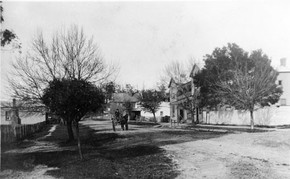STRONG, Albert Victor
| Service Number: | 29789 |
|---|---|
| Enlisted: | 23 March 1916, Prahran, Vic. |
| Last Rank: | Driver |
| Last Unit: | 3rd Field Artillery Brigade |
| Born: | Portarlington, Victoria, Australia, 1892 |
| Home Town: | Cranbourne, Casey, Victoria |
| Schooling: | Not yet discovered |
| Occupation: | Farmer |
| Died: | 6 June 1966, cause of death not yet discovered, place of death not yet discovered |
| Cemetery: |
Springvale War Cemetery, Melbourne, Victoria |
| Memorials: |
World War 1 Service
| 23 Mar 1916: | Enlisted AIF WW1, Driver, 29789, Australian Field Artillery - 116th to 120th Howitzer Batteries: AIF, Prahran, Vic. | |
|---|---|---|
| 3 Oct 1916: | Involvement Driver, 29789, Australian Field Artillery - 116th to 120th Howitzer Batteries: AIF, --- :embarkation_roll: roll_number: '4' embarkation_place: Melbourne embarkation_ship: HMAT Aeneas embarkation_ship_number: A60 public_note: '' | |
| 3 Oct 1916: | Embarked Driver, 29789, Australian Field Artillery - 116th to 120th Howitzer Batteries: AIF, HMAT Aeneas, Melbourne | |
| 28 Apr 1917: | Transferred AIF WW1, Driver, 3rd Field Artillery Brigade , France | |
| 20 Sep 1917: | Involvement AIF WW1, Driver, 29789, 3rd Field Artillery Brigade , Third Ypres | |
| 15 Apr 1918: | Involvement AIF WW1, Driver, 29789, 3rd Field Artillery Brigade , German Spring Offensive 1918 | |
| 8 Aug 1918: | Involvement AIF WW1, Driver, 29789, 3rd Field Artillery Brigade , "The Last Hundred Days" | |
| 8 May 1919: | Discharged AIF WW1, Driver, 29789, 3rd Field Artillery Brigade , RTA 7 February 1919 and discharged (TPE). |
Help us honour Albert Victor Strong's service by contributing information, stories, and images so that they can be preserved for future generations.
Add my storyBiography
Albert Victor Strong – Biography
Albert Victor Strong was born in Portarlington, Victoria, and later lived in ‘Ercildoune’, Cranbourne, Victoria along with his father, William Strong. On Thursday, the 23rd of March 1916, Albert signed up to go to war for the Australian Field Artillery; 116 to 120th Howitzer Batteries (from September to October), at Prahran in Victoria. When he signed up on Thursday 23rd March 1916, Albert’s occupation was a farmer and he was single. At the time he left for war, the colour of his eyes were blue and his hair colour was brown. Albert weighed 140 lbs and was 5 feet and 3.75 inches tall when he filled out the form, and his chest measurement was 33/37.5 inches. Albert Victor Strong had a few distinctive marks, most being moles and he had a scar on his inner right knee. Albert’s religion was Methodist which is protestant Christianity, meaning a follower of John Wesley who is a teacher of Anglican Christianity. His letter was approved of and he was to commence working as a driver in the war on the 2nd of October 1916.
When the 2nd of October came around that year, Albert was in Melbourne, ready for the journey ahead of him. The boat he left off was HMAT Aeneas A60 and he was given the service number of ‘29789’ whilst he was in the war. On the 19th of November 1916, Albert arrived at Plymouth, a port in England, and fought at a battlefront there for approximately 6-7 months. Once he had finished fighting at that battlefront, Albert disembarked from Plymouth and proceeded overseas to Folkestone, also in England, on the 9th of April 1917. On the 20th of April that year, Albert moved on to France and marched to Etaples for 6 days, until he marched out to the 3rd A.F.A.B (alliances formed, alliances broken) also in Etaples. On the 28th of April 1917, Albert commenced fighting for the 3rd Field Artillery Brigade in France for just under 6 months. On the 15th of October that year, Albert left France to travel back to England and had a 13 day leave from war. Re-joining on the 28th of October, Albert fought in England for approximately 9 months, then fought with his unit at France from the 21st of July 1918. On the 7th of February 1919, Albert returned to Australia. After the war, Albert lived another 47 years, dying on the 6th of June in 1966. Albert Victor Strong was buried at the Springvale Cemetery at Clayton in Victoria.
ANZAC stands for Australian and New Zealand Army Corps and an ANZAC is someone from Australia or New Zealand who served for armed services between the years of 1914 and 1918. On the battlefield, some qualities that ANZACs portray are bravery, nationalism and courage. These are possibility the three main traits that most ANZACs would have had during WW1. Bravery was seen when the men and women volunteered to fight for their country, also showing courage, and nationalism was shown in each of them as they had pride in their country and they were prepared to devote their endless support for their country (also patriotic). Being in the war also showed how dedicated someone is, potentially giving up their lives for someone else’s in the future. Considering that these qualities are always shown in an ANZAC fighter, Albert Victor Strong most definitely showed these qualities, as he was a committed fighter.












